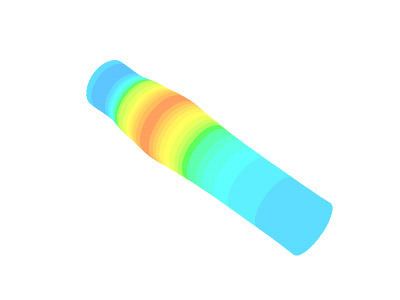 | ||
Fluid–structure interaction (FSI) is the interaction of some movable or deformable structure with an internal or surrounding fluid flow. Fluid–structure interactions can be stable or oscillatory. In oscillatory interactions, the strain induced in the solid structure causes it to move such that the source of strain is reduced, and the structure returns to its former state only for the process to repeat.
Contents
Examples
Fluid–structure interactions are a crucial consideration in the design of many engineering systems, e.g. aircraft, engines and bridges. Failing to consider the effects of oscillatory interactions can be catastrophic, especially in structures comprising materials susceptible to fatigue. Tacoma Narrows Bridge (1940), the first Tacoma Narrows Bridge, is probably one of the most infamous examples of large-scale failure. Aircraft wings and turbine blades can break due to FSI oscillations. Fluid–structure interaction has to be taken into account for the analysis of aneurysms in large arteries and artificial heart valves. A reed actually produces sound because the system of equations governing its dynamics has oscillatory solutions. The dynamic of reed valves used in two strokes engines and compressors is governed by FSI. The act of "blowing a raspberry" is another such example. Fluid–structure interactions also occur in moving containers, where liquid oscillations due to the container motion impose substantial magnitudes of forces and moments to the container structure that affect the stability of the container transport system in a highly adverse manner.
Analysis
Fluid–structure interaction problems and multiphysics problems in general are often too complex to solve analytically and so they have to be analyzed by means of experiments or numerical simulation. Research in the fields of computational fluid dynamics and computational structural dynamics is still ongoing but the maturity of these fields enables numerical simulation of fluid-structure interaction. Two main approaches exist for the simulation of fluid–structure interaction problems:
The monolithic approach requires a code developed for this particular combination of physical problems whereas the partitioned approach preserves software modularity because an existing flow solver and structural solver are coupled. Moreover, the partitioned approach facilitates solution of the flow equations and the structural equations with different, possibly more efficient techniques which have been developed specifically for either flow equations or structural equations. On the other hand, development of stable and accurate coupling algorithm is required in partitioned simulations. In conclusion, the partitioned approach allows reusing existing software which is an attractive advantage. However, stability of the coupling method needs to be taken into consideration.
In addition, the treatment of meshes introduces another classification of FSI analysis. The two classifications are the conforming mesh methods and the non-conforming mesh methods.
Numerical simulation
The Newton–Raphson method or a different fixed-point iteration can be used to solve FSI problems. Methods based on Newton–Raphson iteration are used in both the monolithic and the partitioned approach. These methods solve the nonlinear flow equations and the structural equations in the entire fluid and solid domain with the Newton–Raphson method. The system of linear equations within the Newton–Raphson iteration can be solved without knowledge of the Jacobian with a matrix-free iterative method, using a finite difference approximation of the Jacobian-vector product.
Whereas Newton–Raphson methods solve the flow and structural problem for the state in the entire fluid and solid domain, it is also possible to reformulate an FSI problem as a system with only the degrees of freedom in the interface’s position as unknowns. This domain decomposition condenses the error of the FSI problem into a subspace related to the interface. The FSI problem can hence be written as either a root finding problem or a fixed point problem, with the interface’s position as unknowns.
Interface Newton–Raphson methods solve this root-finding problem with Newton–Raphson iterations, e.g. with an approximation of the Jacobian from a linear reduced-physics model. The interface quasi-Newton method with approximation for the inverse of the Jacobian from a least-squares model couples a black-box flow solver and structural solver by means of the information that has been gathered during the coupling iterations. This technique is based on the interface block quasi-Newton technique with an approximation for the Jacobians from least-squares models which reformulates the FSI problem as a system of equations with both the interface’s position and the stress distribution on the interface as unknowns. This system is solved with block quasi-Newton iterations of the Gauss–Seidel type and the Jacobians of the flow solver and structural solver are approximated by means of least-squares models.
The fixed-point problem can be solved with fixed-point iterations, also called (block) Gauss–Seidel iterations, which means that the flow problem and structural problem are solved successively until the change is smaller than the convergence criterion. However, the iterations converge slowly if at all, especially when the interaction between the fluid and the structure is strong due to a high fluid/structure density ratio or the incompressibility of the fluid. The convergence of the fixed point iterations can be stabilized and accelerated by Aitken relaxation and steepest descent relaxation, which adapt the relaxation factor in each iteration based on the previous iterations.
If the interaction between the fluid and the structure is weak, only one fixed-point iteration is required within each time step. These so-called staggered or loosely coupled methods do not enforce the equilibrium on the fluid–structure interface within a time step but they are suitable for the simulation of aeroelasticity with a heavy and rather stiff structure. Several studies have analyzed the stability of partitioned algorithms for the simulation of fluid-structure interaction .
